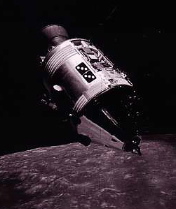
The day Laurie Anderson spoke at Meyerson Hall (see Libby’s post for more on Anderson) I went up to Taller Puertorriqueno to see New York-based Puerto Rican artist Adal Maldonado’s “Blueprints for a Nation” and “Coconauts in Space.” As I listened to Anderson, the newly-appointed NASA artist in residence, and heard former ICA director Janet Kardon introduce Anderson and reminisce about how she (Kardon) curated the now famous exhibit of Robert Mappelthorpe’s photographs, I realized there was common ground between Anderson and Maldonado — and that some of it was in outer space. (top image is the Domino 1 space craft from “Coconauts” and below is Commandante Adal, captain of Domino 1)
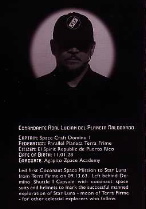
For starters, the two artists are spacey, and I mean that in a good way. They share an orientation to the world that is integrative, other-worldly and full of big thoughts about social issues. (For more information on Maldonado, see his website.)
Then, there’s an outer space connection. Anderson’s NASA involvement, which is a little undefined, allows her access to Hubble space telescope imagery. In her talk, she showed slides illustrating how she proposed to integrate space imagery into a Japanese garden.
In “Coconauts,” Maldonado, too, uses NASA material, altering shots from the 1969 NASA moon landing and integrating them into a little invented history — of a prior lunar landing, in 1963, by Puerto Rican astronauts, himself included.
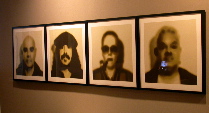
Both artists use electronic media in their work. In her ICA show in 1983, Anderson created a sound sculpture that required the viewer to place her head on a pillow to receive a message. In his “Blueprints” piece, Maldonado — who told me he had no knowledge of the Anderson piece — created an altar to Saint Anthony (Marc Anthony) that invites the viewer to kneel down and place her head on a pillow to receive the soothing music of Saint Anthony. (image below)
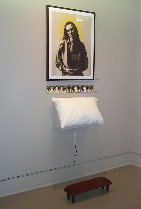
Here I’ll bring up Mapplethorpe, whom Kardon spoke of in her introduction. Maldonado, who is a trained photographer and master printer, was Mapplethorpe’s printer early on and helped that artist develop a printing style. (left is image of blurry Nuyoricans from “Blueprints”)
And that’s as far as I’ll take this comparison between Anderson and Maldonado, except to say that they’re both great.
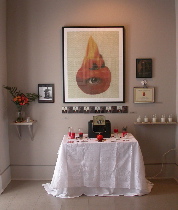
Here’s more on Maldonado and his show, which I highly recommend. The multi-media artist uses video, audio, performance, digital manipulation of photography, sculpture and text.
His work, which is included in the show of Latino art from the MOMA collection at Museo del Barrio is about the state of being Puerto Rican in America, a condition so unempowered, so disenfranchised he calls it “blurry” or “borroso.” (image above left is altar from La Santa Iglesia de la Madre de los Tomates)
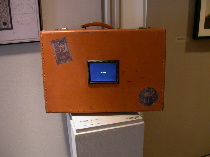
Maldonado wants to empower the blurry citizenry and to that end, working in collaboration with the late poet Pedro Pietri, he has created a new sovereign state, “El Spirit Republic de Puerto Rico.” It’s an alternate universe that celebrates the condition of being Puerto Rican in America. “Blueprints” offers a bodega’s-worth of products for this new republic, everything from passports, money and postage stamps, to an official state church, “La Santa Iglesia de la Madre de los Tomates” (Holy Church of the Mother of the Tomatoes). (image above right is suitcase which contains video piece merging West Side Story images and a dolorous chanteuse who sings of her longing for Puerto Rico)

“Coconauts'” invented history is uplifting material for the citizens of the spirit republic. Maldonado suggests that unless you tell the tale, history will forget you.
While the work bears no physical resemblance to the work of Russian emigre artists Vitaly Komar and Alex Melamid, its spirit of serious play with social and political underpinnings is similar. I’d also like to say that the myth making and story aggrandizement reminds me of work by other artists who also seem to be trying to correct the record of history. Pepon Osorio and his “Casita” is one example (see my June 20 post. Kara Walker is another. But even young artists like Amy Cutler and Clare Rojas are creating alternate — empowering — universes which seem to be sticking it to traditional white, male visions of history.

Maldonado, a self-described “country boy” or “jibaro” who grew up in the island’s mountainous interior, posits that every element of the pre-New York experience is clear and that it’s only after arriving in America that the Puerto Rican becomes blurry. The artist offers as evidence photographs and videos of his native land that are crisp and clear documentation of a rural lifestyle.
Crediting his jibaro roots for his ability to tell tall tales and use humor in his art the artist explained in an email
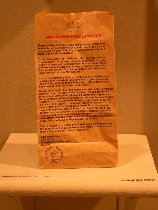
“Country folk from all over the world are known for spinning far out yarns…that incorporate subjective realities, mysticism and humor. This reminds me of an account of what happened in my home town during hurricane season when I was just a boy. An old lady was seen flying through the plaza (she got swept up by the strong hurricane winds I guess) but all the townfolks swore she was a UFO. This would probably be thought of as surrealism by art scholars but to us it was our normal everyday experience.”
(image left is a bodega bag declaring the annexation of New York city to the Spirit Republic)
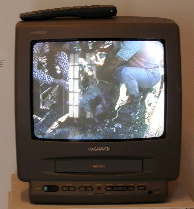
On the creation of his spirit republic, Maldonado says “lately I’ve been thinking that people could construe El Spirit Republic as another example of the reconstruction of the Garden of Eden (Walden Pond, Shangrila, Atlantis, Xanadu, etc) –a failed project from the start…My position is that there can be no Garden of Eden, no Shangrila once you put two people in the same environment.. Because we have free will and we perceive differently, there is going to be conflict and eventually dissent…and learning how to resolve these [conflicts] helps us transcend our condition by tapping into the spirit within. (bottom image shows video from the non-blurry homeland — the slaughtering of a pig for a feast to celebrate a holy day)









